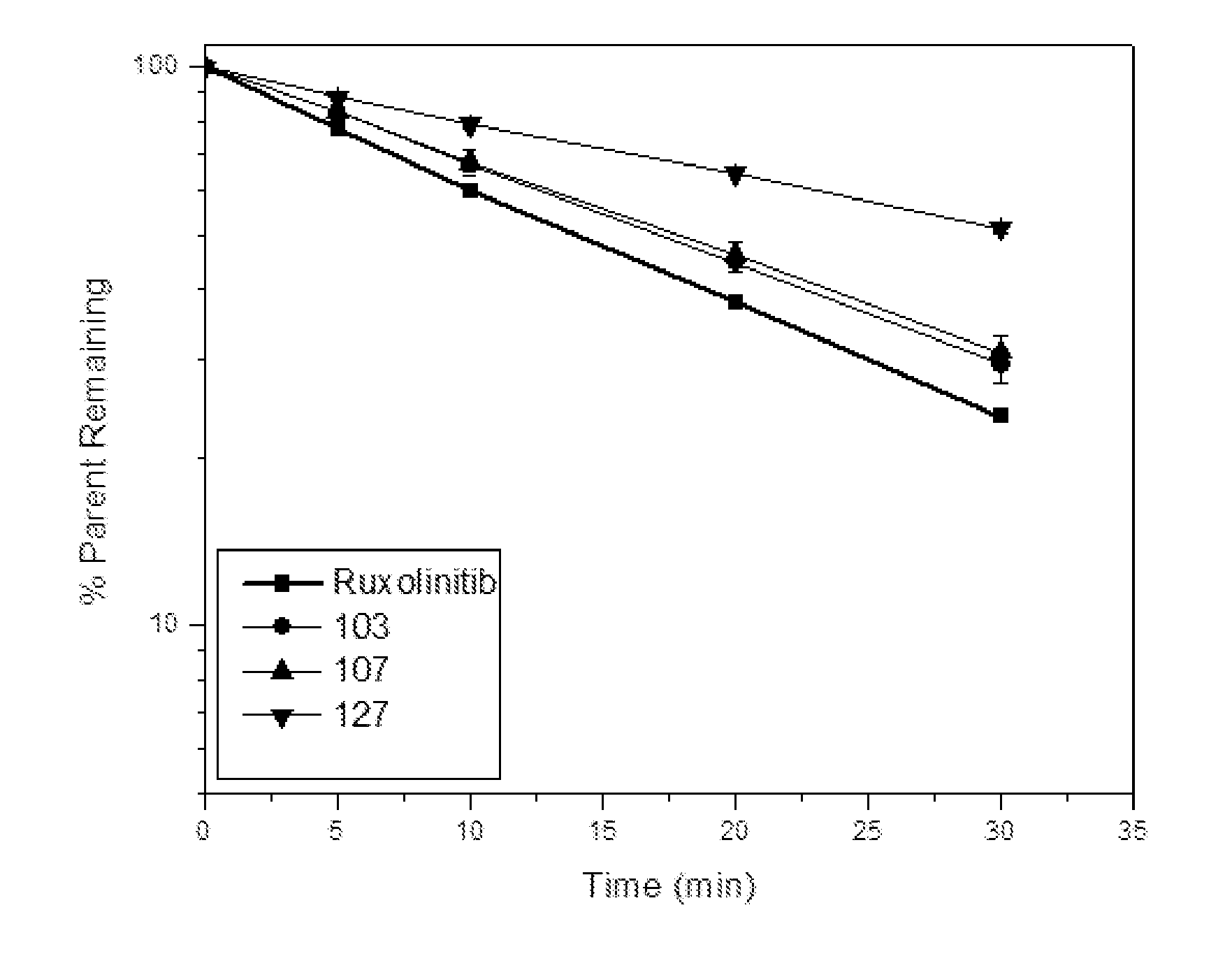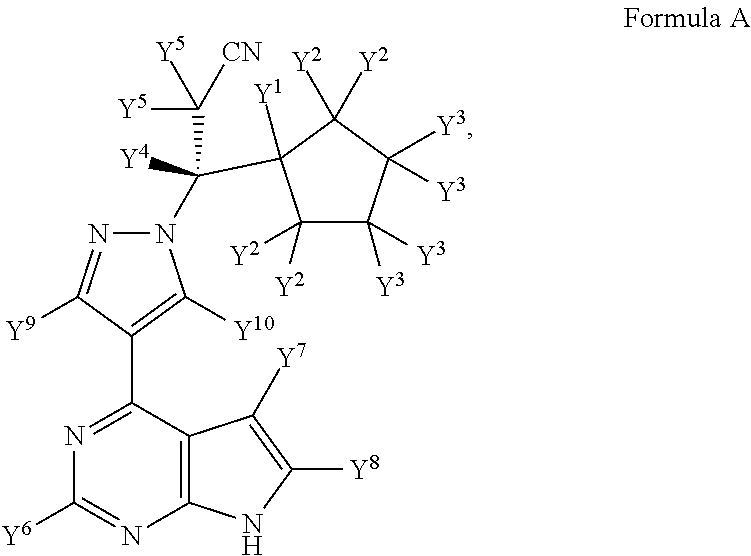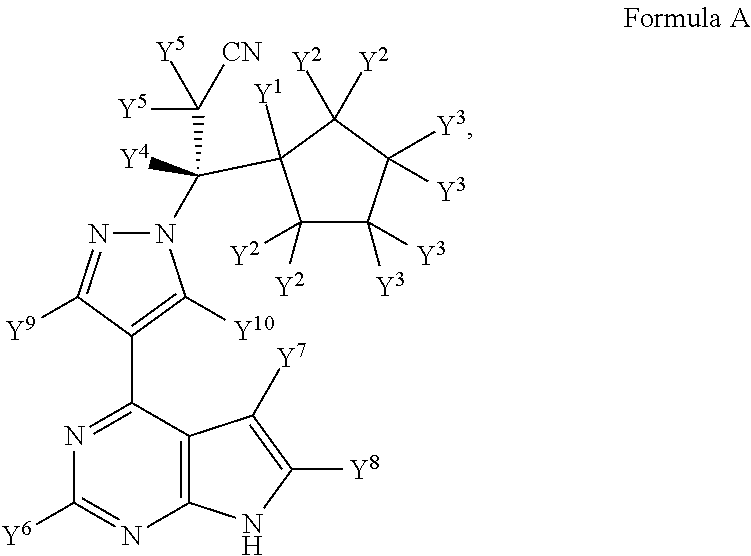Deuterated derivatives of ruxolitinib
a derivative and ruxolitinib technology, applied in the field of deuterated derivatives of ruxolitinib, can solve the problems of poor absorption, distribution, metabolism and/or excretion (adme) properties, poor adme properties, and many current medicines
- Summary
- Abstract
- Description
- Claims
- Application Information
AI Technical Summary
Benefits of technology
Problems solved by technology
Method used
Image
Examples
example 1
Synthesis of (R)-3-(4-(7H-Pyrrolo[2,3-d]pyrimidin-4-yl)-1H-pyrazol-1-yl)-3-(2,2,5,5-d4-cyclopentyl)propanenitrile (Compound 107)
[0111]
[0112]Step 1. Diethyl 2,2,5,5-d4-cyclopentane-1,1-dicarboxylate (32). To a solution of diethyl malonate (6.57 mL, 43.3 mmol) in ethanol (40 mL) was added a 21 wt % solution of sodium ethoxide in ethanol (32.3 mL, 86.6 mmol) followed by 1,1,4,4-tetradeutero-1,4-dibromobutane (31, 5.53 mL, 45.5 mmol, CDN Isotopes, 98 atom % D). The resulting solution was stirred at reflux for two hours then cooled to room temperature and diluted with excess water. The majority of the ethanol was then removed via distillation and the resulting aqueous solution was extracted with ethyl acetate (3×75 mL). The organic layers were combined, washed with brine, dried (Na2SO4), filtered and concentrated under reduced pressure to afford 32 as a yellow oil which was carried forward without purification. (9.45 g, 100%).
[0113]Step 2. 2,2,5,5-d4-Cyclopentane-1-carboxylic acid (33). ...
example 2
Synthesis of (R)-3-(4-(7H-Pyrrolo[2,3-d]pyrimidin-4-yl)-1H-pyrazol-1-yl)-3-(3,3,4,4-d4-cyclopentyl)propanenitrile (Compound 103)
[0121]
[0122]Step 1. Diethyl 3,3,4,4-d4-cyclopentane-1,1-dicarboxylate (40). To a solution of diethyl malonate (3.25 mL, 21.4 mmol) in ethanol (20 mL) was added a 21 wt % solution of sodium ethoxide in ethanol (16.0 mL, 42.8 mmol) followed by 2,2,3,3-tetradeutero-1,4-dibromobutane (39, 4.95 g, 22.5 mmol, CDN Isotopes, 98 atom % D). The resulting solution was stirred at reflux for two hours then cooled to room temperature and diluted with excess water. The majority of the ethanol was then removed via distillation and the resulting aqueous solution was extracted with ethyl acetate (3×75 mL). The organic layers were combined, washed with brine, dried (Na2SO4), filtered and concentrated under reduced pressure to afford 40 as a yellow oil which was carried forward without purification. (4.67 g, 100%).
[0123]Step 2. 3,3,4,4-d4-Cyclopentane-1-carboxylic acid (41). T...
example 3
Synthesis of (R)-3-(4-(7H-Pyrrolo[2,3-d]pyrimidin-4-yl)-1H-pyrazol-1-yl)-3-(cyclopentyl-d9)propanenitrile (Compound 127)
[0131]
[0132]Step 1. Diethyl 2,2,3,3,4,4,5,5-d8-Cyclopentane-1,1-dicarboxylate (47). To a solution of diethyl malonate (6.24 mL, 41.1 mmol) in ethanol (40 mL) was added a 21 wt % solution of sodium ethoxide in ethanol (30.7 mL, 82.2 mmol) followed by 1,1,2,2,3,3,4,4-octadeutero-1,4-dibromobutane (46, 9.67 g, 43.2 mmol, CDN Isotopes, 98 atom % D). The resulting solution was stirred at reflux for two hours then cooled to room temperature and diluted with excess water. The majority of the ethanol was then removed via distillation and the resulting aqueous solution was extracted with ethyl acetate (3×75 mL). The organic layers were combined, washed with brine, dried (Na2SO4), filtered and concentrated under reduced pressure to afford 47 as a yellow oil (9.12 g, 100%) which was carried forward without purification.
[0133]Step 2. Perdeuterocyclopentane-1-carboxylic acid (4...
PUM
| Property | Measurement | Unit |
|---|---|---|
| Therapeutic | aaaaa | aaaaa |
Abstract
Description
Claims
Application Information
 Login to View More
Login to View More - R&D
- Intellectual Property
- Life Sciences
- Materials
- Tech Scout
- Unparalleled Data Quality
- Higher Quality Content
- 60% Fewer Hallucinations
Browse by: Latest US Patents, China's latest patents, Technical Efficacy Thesaurus, Application Domain, Technology Topic, Popular Technical Reports.
© 2025 PatSnap. All rights reserved.Legal|Privacy policy|Modern Slavery Act Transparency Statement|Sitemap|About US| Contact US: help@patsnap.com



